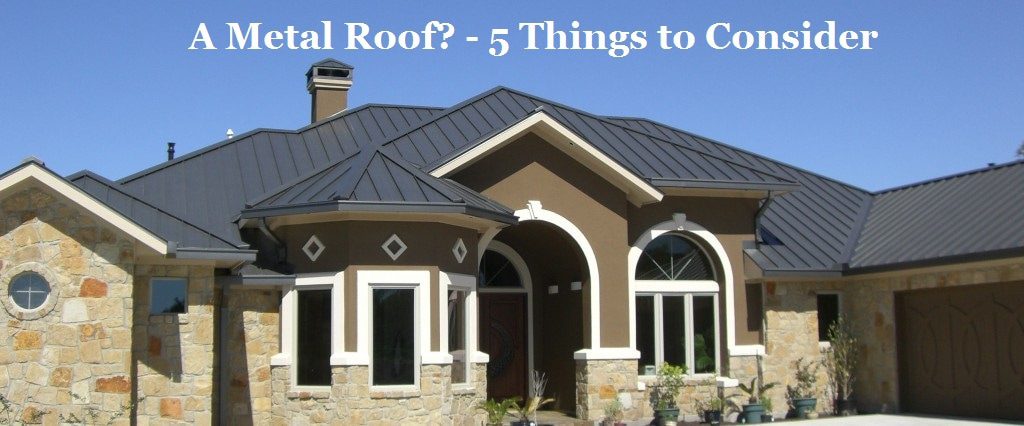
If there is one constant when buying or owning a home, it’s the roof. You may have gas or electric heat, solar hot water, a septic system or municipal waste management, but every home has a roof. And eventually, that roof needs replacement. Installing a metal roof on your home comes with some major benefits and some drawbacks.
The average life span of an asphalt shingle roof, which is the most common roofing material, is about 20 years. So there’s a good chance you’ll need to replace your roof at least once if you own a home for any length of time. In that period, you may need to make repairs, as well. Even a small leak in your roof can lead to damage throughout your home, such as mold within the walls, and even structural problems if the leak goes unnoticed for a long time.
Asphalt shingles aren’t the only roofing material, however. There are five common roofing materials: asphalt shingles, wood shingles, metal, tile, and slate. A metal roof has some distinct qualities that might make it the right choice for you.
Installing a metal roof: The good, the bad, the ugly
1. What is a metal roof?
A metal roof is constructed from aluminum, steel, copper, or a copper/asphalt blend. Metal roofs don’t have to “look” metal, though. Advances in construction and fabrication can give you a metal roof that looks like classic wood shingles, tile, or slate.
It’s also worth noting that metal roofs have come a long way since the days of the flimsy tin roof on the old barn. If you’re replacing your roof, it behooves you to look into the new materials and construction.
2. How long will a metal roof last?
According to the Metal Roofing Alliance, the lifespan of a metal roof is between 40 and 60 years. The International Association of Certified Home Inspectors places the average life of a metal roof between 40 and 80 years.
For the sake of comparison, an asphalt shingle roof needs replacement within 20 years. A tile roof will give you at least 80 years, and possibly more. A slate roof is the longest lasting (and most expensive) with a lifespan of over 100 years.
3. How much will a metal roof cost?
This is, of course, one of the big questions. Installing a metal roof, or any roof, is a big job. Contractors may have wildly different quotes, depending on the location, the type of roof you have, or even how busy they are. It isn’t just the contractor that determines the price, however. These factors also play into the cost of any new roof:
- The size of your roof
- The material (copper will cost more than steel, for instance)
- The pitch of your roof (a steeper incline requires more labor)
- Removal of an old roof
- The “landscape” of your roof (multiple chimneys, skylights, or valleys increase the complexity of the job)
These are all upfront costs. The other end of the cost spectrum includes longevity and maintenance. You could pay two or three times more for a metal roof than you would for an asphalt shingle roof, but it may last two or three times as long.
According to Bob Vila, when you spread the total expenses out, “a standing-seam metal roof is the least costly roof option over the life of the roof because it is virtually maintenance-free and can last 50 years or more.”
Understanding the many factors that go into the expense of installing a metal roof, there is still a national average price of between $14,000 and $16,000 as calculated by Roofing Calculator. By comparison, an asphalt shingle roof is around $6,500, and a tile roof runs about $18,000.
4. Is a metal roof safe?
The short answer is yes. A properly manufactured and installed metal roof is fire-resistant, is non-combustible, and can withstand hurricane force winds. And, no, it will not attract lightning any more than any other roofing material.
5. Is a metal roof environmentally friendly?
A metal roof is green in more ways than one. Manufacturers can make metal roofs with up to 95% recycled material, and if you do ever replace your roof, they are entirely recyclable. Installing a metal roof comes with plenty of indirect ecological benefits, too.
Add a reflective coating to a metal roof, and you could save an average of 40% of your summer cooling costs. The longevity of a metal roof also decreases the drain on resources to repair or replace a shorter-lived roof.
The downside to this is, of course, the initial use of natural resources to make and install the roof in the first place. You may find that proper maintenance and repair of your current roof (along with other energy-reducing habits) is more environmentally friendly than installing a metal roof.
No matter what kind of roof you have, a home insurance policy will help you retain the value of your home in the event of an accident.
EMERGE INSURANCE AGENCY
904-677-5884


